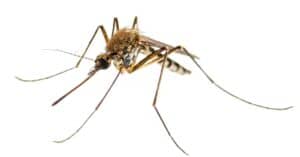Summer evenings in Mississippi can be delightful, but not when mosquitoes are buzzing around. Despite appearing similarly to one another, every mosquito species possesses distinct characteristics. Some mosquitoes have a particular taste for human blood, while others prefer animals’ blood. To add to the complexity, some carry lethal diseases, while others are not as dangerous as they seem.
Having knowledge about the various species of mosquitoes in Mississippi can assist you in safeguarding yourself and your dear ones. So, let’s dive in and discover the fascinating world of mosquitoes in Mississippi!
Asian Tiger Mosquito (Aedes albopictus)
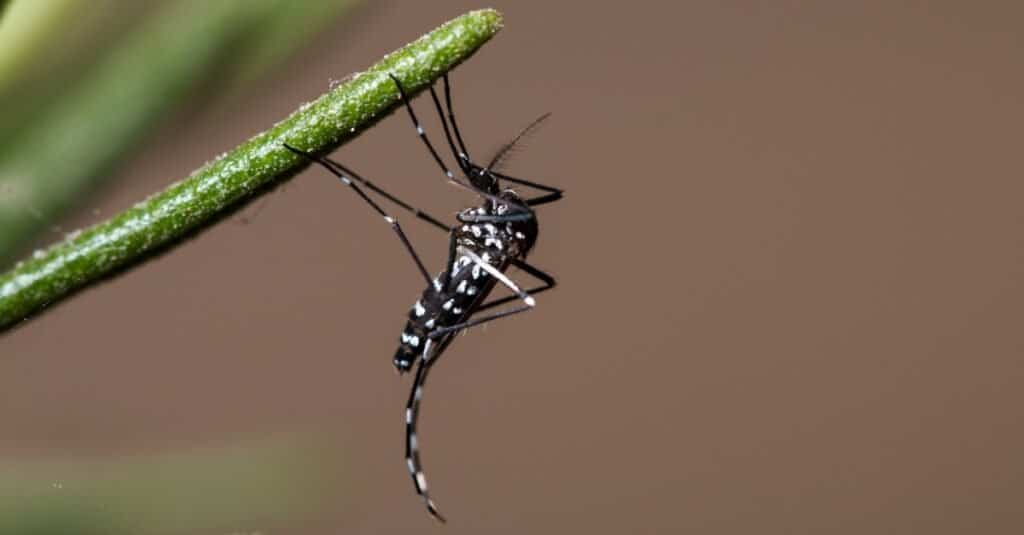
Originating from Southeast Asia, the Asian
tiger
mosquito has adapted well to urban living.
©Oliver Spiteri/Shutterstock.com
The Asian tiger mosquito, an exotic species, was initially identified in Mississippi in 1989. Although the state hosts over 50 distinct mosquito species, the Asian tiger mosquito is the most widespread. They are particularly common in urban settings and near water sources.
Originating from Southeast Asia, the Asian tiger mosquito has adapted well to urban living. It commonly inhabits areas like residential yards, parks, and additional green spaces. These mosquitoes are diurnal and are notorious for their aggressive biting habits. They can transmit some deadly viruses such as Chikungunya, West Nile, Dengue, and Zika. While male mosquitoes consume plant nectar, females rely on the blood of various animals, including humans, squirrels, dogs, and deer.
Plant juices serve as the primary source of nutrition for male mosquitoes. In contrast, female mosquitoes require blood for the development of their eggs and actively seek it out.
The population of Asian tiger mosquitoes in Mississippi peaks during the warmest months, typically from May through September. Their emergence can fluctuate based on temperature and precipitation patterns. These pesky insects go into a dormant state with the arrival of fall and sometimes winter.
You may be forced to deal with Asian tiger mosquitoes all year round. They can survive during winter in favorable microenvironments.
Yellow Fever Mosquito (Aedes aegypti)
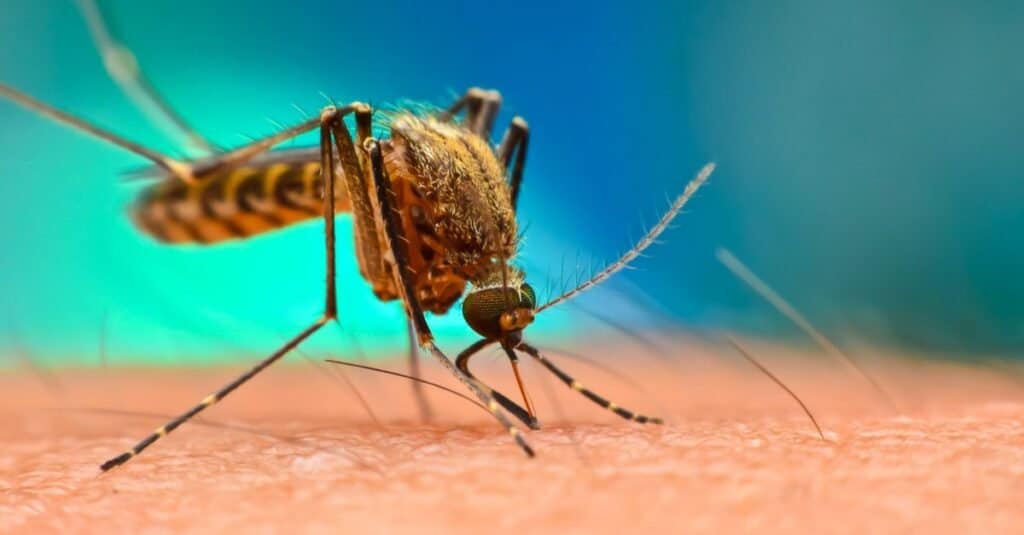
These mosquitoes prefer to breed in containers such as spare tires, drainage ditches, unused flowerpots, and untreated swimming pools.
©Digital Images Studio/Shutterstock.com
Another commonly found mosquito species in Mississippi is the yellow fever mosquito. It is infamous for its ability to transmit the yellow fever virus, hence its name. Sadly, there is currently no specific antiviral medication developed for treating this disease. But thankfully, there is a vaccine!
Yellow fever mosquitoes contract the virus while feeding on infected primates and can transmit it to other primates, including humans. These mosquitoes can also transmit the Dengue virus, further increasing their potential danger.
These mosquitoes prefer to breed in containers such as spare tires, drainage ditches, unused flowerpots, and untreated swimming pools. These urbanized insects thrive in areas with a high human population, which makes them an exceptionally successful vector for diseases.
While yellow fever mosquitoes feed on plant juices and nectar, females require blood to lay their eggs. Their aggressive stinging behavior makes them one of the most unpleasant mosquito species to encounter in Mississippi.
Yellow fever mosquitoes are most active from spring to fall when temperatures are warm. Their population decreases in colder weather. During winter, they either die off or enter a state of hibernation, known as diapause.
Southern House Mosquito (Culex quinquefasciatus)

Found in the Southern United States, particularly throughout Mississippi, the southern house mosquito breeds in and around stagnant water.
©iStock.com/Arnav Ray
The southern house mosquito can pose a risk not just to humans but also to animals like cats, birds, and dogs. This species is a primary carrier of various pathogens, including West Nile virus from the flavivirus family and the phlebovirus Rift Valley fever virus, as well as filarial worms and avian malarial parasites.
Found in the Southern United States, particularly throughout Mississippi, the southern house mosquito breeds in and around stagnant water, such as old tires, bird baths, and other water-containing containers. These mosquitoes, like other mosquito species, feed on plant nectar.
After mating, females seek multiple blood meals, while males survive on sugar meals alone. These female mosquitoes have an opportunistic feeding habit, preferring to feed on birds and mammals during the night.
As soon as spring arrives in Mississippi, large numbers of these mosquitoes emerge. While the southern house mosquito’s breeding cycle typically takes around one to two weeks in high summer temperatures, they have the ability to breed all year round in any location within their geographical range, even during the winter months.
Common Malaria Mosquito (Anopheles quadrimaculatus)
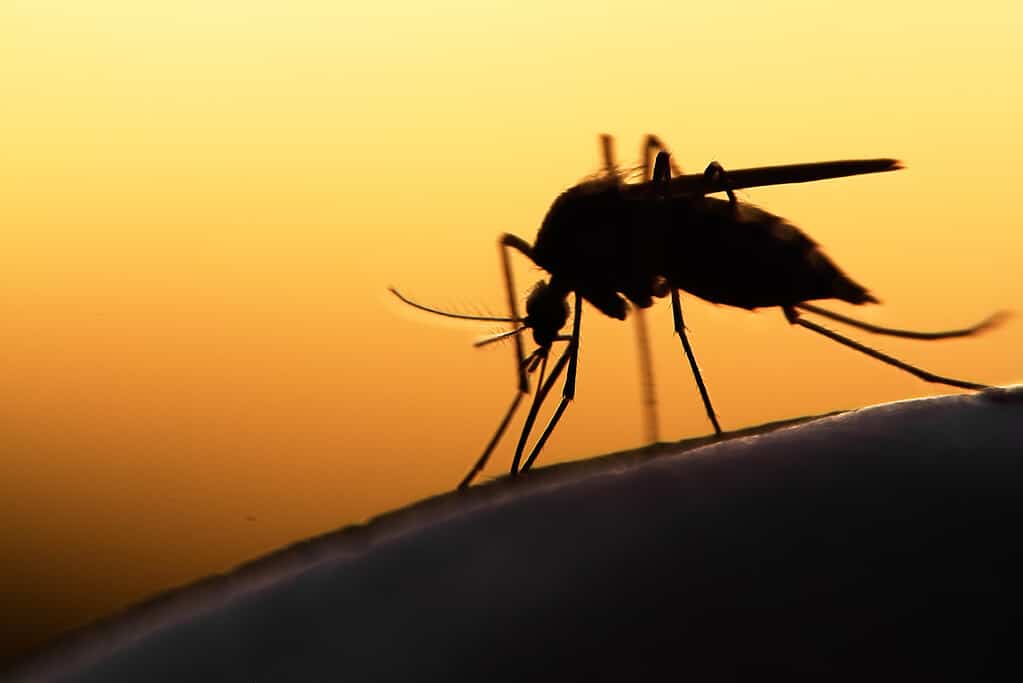
This species, originally from South Asia and the Arabian Peninsula, is notorious for transmitting malaria to humans.
©mycteria/Shutterstock.com
Anopheles quadrimaculatus, a well-known malaria vector in Mississippi, is abundant throughout much of the state, and its population numbers are relatively high. This species, originally from South Asia and the Arabian Peninsula, is notorious for transmitting malaria to humans.
These mosquitoes tend to favor breeding in natural and unobstructed bodies of water, such as sandy riverbeds and calm waters. Additionally, larvae are abundant in habitats with permanent and full sunlight, without algae and vegetation. The water temperature has a positive correlation with the density of larvae.
To obtain energy, both male and female adults consume plant sugars and nectar. However, females require additional nutrients for egg development and obtain them by feeding on blood. While they are known to feed on a variety of mammals, including humans, they also target domestic and wild animals.
The World Health Organization (WHO) reported that in 2021, around 619,000 deaths were attributed to malaria worldwide. The common malaria mosquito is reportedly an endophilic species that aggressively attacks humans.
The prevalence of malaria increases during the rainy season, as the wet and damp conditions create ideal breeding habitats for mosquitoes. These mosquitoes are prevalent in Mississippi during summer and rainy seasons, but they may appear in winter months with mild and humid weather, although it is uncommon. They usually disappear from fall to spring.
However, it’s not all bad news. While the mosquito species can be found throughout Mississippi, the common malaria mosquito is not currently considered a significant risk for malaria transmission in the state.
Black-Tailed Mosquito (Culiseta melanura)
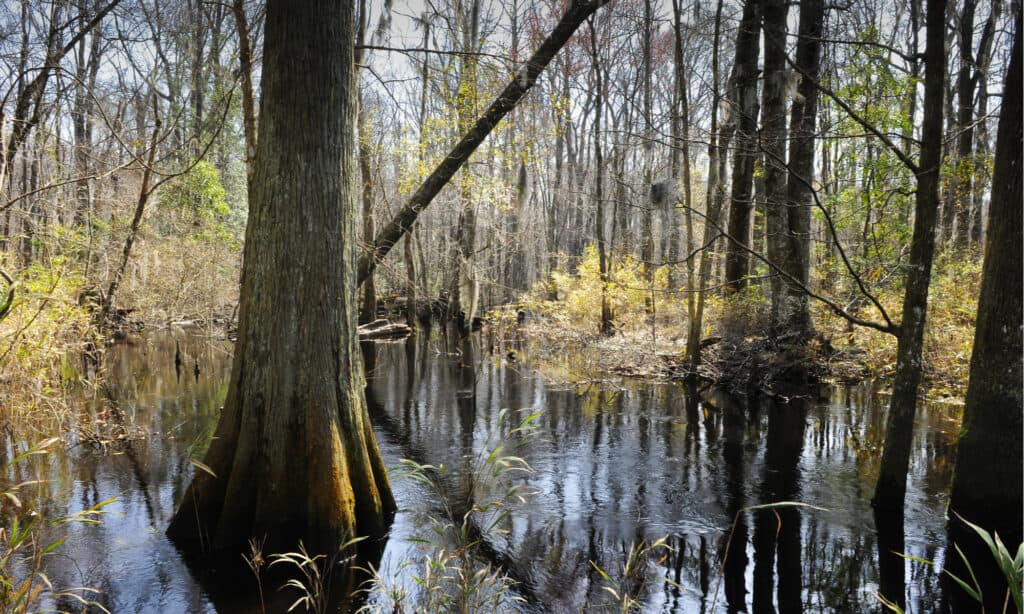
Black-tailed mosquitoes generally breed in acidic, swampy water with a pH of around 5.
©Don Fink/Shutterstock.com
The Culiseta melanura, or black-tailed mosquito, is a member of the Culicidae family. This mosquito species is unique in Mississippi because it survives the winter as larvae, whereas most other species overwinter as adults or eggs. The black-tailed mosquito is significant due to its involvement in transmitting possibly the West Nile virus and the eastern equine encephalitis virus.
These mosquitoes can be found in diverse habitats, ranging from marshy wetlands to water-filled old tires. Black-tailed mosquitoes generally breed in underground chambers and decaying trees and prefer acidic, swampy water with a pH of around 5.
Adult females predominantly feed on bird blood, with species like the American robin, wood thrush, and gray catbird being their preferred hosts. Blood-feeding activity peaks during the first two hours following sunset but persists at a reduced rate until sunrise. Since Culiseta melanura does not significantly bother humans, it is not typically targeted for mosquito control.
Black-tailed mosquitoes are usually present between May and October, with summer being their preferred season. Encounters with these mosquitoes are relatively rare in Mississippi from fall to spring.
When Are Mosquitoes at Their Peak in Mississippi?
Mosquitoes are a persistent issue in Mississippi, with the mild winters and hot summers providing a perfect environment for these blood-sucking insects. Even in the low season of winter, mosquito activity never really goes away completely.
The peak season for mosquitoes in Mississippi is typically from late spring to fall, with major outbreaks often reported during this time. Several factors, including the absence of cold days and above-average rainfall, can also contribute to increased mosquito activity.
Other Insects Set to Emerge in Mississippi
Apart from mosquitoes, some other insects are also eagerly waiting for the right time to emerge in Mississippi as the weather warms up. Let’s have a look at some of them.
Synchronous Fireflies (Photinus carolinus)
Mississippi is one of the few fortunate places where synchronous fireflies can be found. These fireflies are a unique species that synchronize the flashing of their lights, making them very special. This phenomenon primarily occurs for mating purposes, with some insects emitting green-yellow light while others give off a blue light.
Typically, synchronous fireflies can be found in permanently wet areas of dry habitats, such as marshy regions along desert streams. Due to their congregating behavior, these firefly species are particularly susceptible to extinction due to human-caused habitat modifications and droughts.
In Mississippi, these fireflies can be observed lighting up the dark hollows from late May to early June every night. Synchronous fireflies are extremely rare and witnessing their stunning displays is a once-in-a-lifetime experience.
Green Darner Dragonflies (Anax junius)
The common green darner dragonfly is a strikingly colored member of the Aeshnidae family, with a large body and prominent eyes. This species is widely distributed throughout Mississippi. Adult green darners have a long abdomen that measures between 2.5 to 3 inches and a wingspan of 3.5 to 4 inches.
During the summer months, the common green darner can be observed flying around warm, still bodies of water, such as lakes, ponds, wetlands, marshes, and the backwaters of slow streams. These dragonflies have been noted to reach speeds of up to 35 miles per hour when in flight. Both in their larval and adult stage, green darner dragonflies are fierce predators.
The prime time for observing common green darner in Mississippi is from mid-April to mid-October.
Luna Moths (Actias luna)
The Saturniidae family boasts of the majestic luna moth, recognized by its lime-green color and wingspan that can measure up to 4.5 inches, making it one of Mississippi’s largest moths. Its forewings have a dark leading edge, while the hindwings have a long tapering tail and four wings that bear an eyespot. Luna moths have feathery antennae.
These moths thrive in deciduous woodlands and their vicinity, where they can find walnut, hickory, persimmon, and sweet gum, which serve as their primary food during their larval stage.
An intriguing fact about adult luna moths is that they possess vestigial mouthparts and lack a digestive system, resulting in a complete absence of feeding behavior. Their primary objective in their short life is to reproduce, with only about a week to do so before their inevitable death.
Luna moths have one generation per year, with winged adults emerging in late May or early June. In contrast, in the southern parts of their range, they can have up to three generations per year, with the first appearing as early as March in Mississippi.
Red Imported Fire Ants (Solenopsis invicta)
Mississippi has many red imported fire ants. Their dark reddish-brown workers come in varying sizes, ranging from 1/16 to 1/5 inch long. Native to South America, these ants were unintentionally introduced to the United States.
Red imported fire ants display a range of behaviors that help them thrive in different environments. For instance, they build rafts to avoid getting swept away by rising water levels. Additionally, they exhibit necrophoric behavior, which means they discard dead ants and scraps outside their nest. These ants are highly adaptable and reside in habitats such as rainforests, deserts, grasslands, and near buildings and roads.
The painful stings of these ants cause intense itching, which can be quite unbearable.
The mating flights of red imported fire ants facilitate their natural spread. Typically, the spread is within a mile or less, although some flights have extended as far as 12 miles. These flights occur during spring or early summer, a day or two after rainfall when the weather is warm and sunny and the wind is calm. These ants hide in their mounds to survive the winter season. People mostly see them from spring to fall.
Red Wasp (Polistes carolina)
Red wasps in Mississippi can grow up to an inch in length. They have a striking appearance, with a red body and dark, purplish-black wings. These wasps tend to build their nests in close proximity to human activity, making them easily agitated. They gather nectar from plants and hunt for live insects in gardens.
Red paper wasps prefer to construct their nests in sheltered areas, such as tree hollows, undersides of bridges, and eaves of buildings. These nests can grow to be quite large, with populations ranging from 3,000 to 5,000 individuals.
Despite their formidable appearance, red wasps are generally not aggressive unless provoked. They will only attack if they feel their nest or themselves are in danger. Female wasps are the only ones capable of stinging, and they can deliver multiple stings without dying, unlike bees.
Typically, red wasps commence the construction of their nests during spring, when the temperature rises, and they stay active until the end of summer. During the winter, the wasp colonies will begin to decline, not because of the cold weather but due to the lack of food.
The photo featured at the top of this post is © iStock.com/Kwangmoozaa
Thank you for reading! Have some feedback for us? Contact the AZ Animals editorial team.




